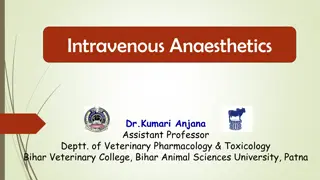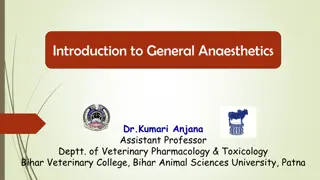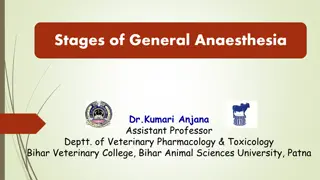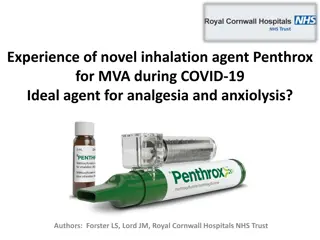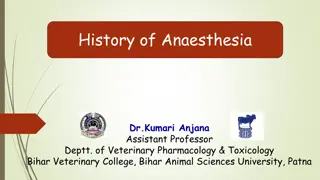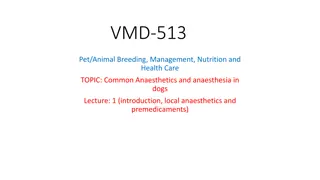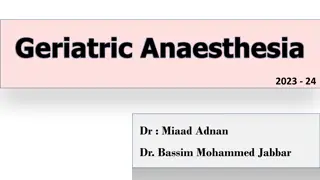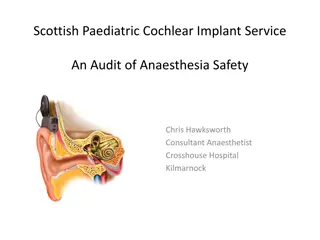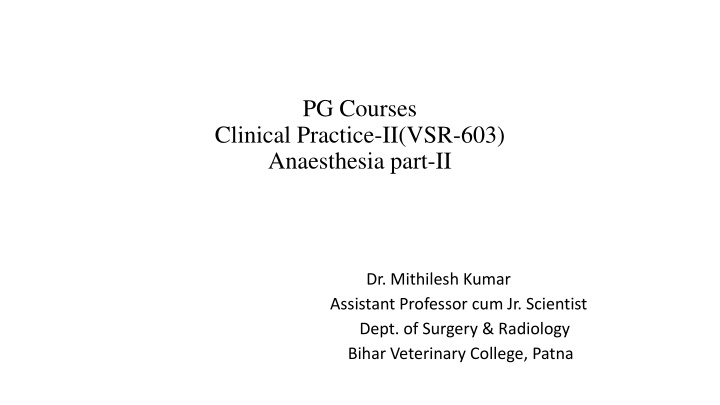
Anaesthesia in Veterinary Clinical Practice
Explore the use of local anaesthetics, including drug administration and suitable types, as well as the benefits and considerations of inhalation anaesthesia in the veterinary field. Learn about the phases of inhalant anaesthesia and how it impacts different body systems to ensure safe and effective procedures. Gain insights into the important role of anaesthesia in veterinary surgery and radiology practices. Discover key concepts such as prolonging local anaesthetic action, using hyaluronidase enzyme, and the characteristics of suitable local anaesthetics.
Download Presentation

Please find below an Image/Link to download the presentation.
The content on the website is provided AS IS for your information and personal use only. It may not be sold, licensed, or shared on other websites without obtaining consent from the author. If you encounter any issues during the download, it is possible that the publisher has removed the file from their server.
You are allowed to download the files provided on this website for personal or commercial use, subject to the condition that they are used lawfully. All files are the property of their respective owners.
The content on the website is provided AS IS for your information and personal use only. It may not be sold, licensed, or shared on other websites without obtaining consent from the author.
E N D
Presentation Transcript
PG Courses Clinical Practice-II(VSR-603) Anaesthesia part-II Dr. Mithilesh Kumar Assistant Professor cum Jr. Scientist Dept. of Surgery & Radiology Bihar Veterinary College, Patna
DRUG ADMINISTERED WITH LOCAL ANAESTHETIC:- (i) Epinephrine:- LA action prolong in few quantity in addition. At the rate of 1:50,000 to 1: 2,00,000 It brings constriction of blood vessels Decrease rate of absorption Reduce chance of toxicity
Hyaluronidase: Mucolytic enzyme Increasing diffusion into tissue Desensitization of larger area Disadvantage decrease duration of anaesthesia 150-200 TRU in 50-150 ml of anaesthetic agent
Suitable Local anaesthetic:- Free soluble in water Heat stable Nearly neutral pH Effective on sensory nerve ending
Long duration and reversible action Rapid recovery Devoid addictive properties. Minimal systemic reaction
INHALATION ANAESTHESIA Absorbed, transported and excreted from the body without change. Halothane metabolised and excreted through the kidney Anaesthetic effect can be reversed by elimination through lungs Intravenous agents cannot be voluntarily eliminated
Inhalant anaesthesia is comparatively expensive. Most controllable anaesthesia. Grouped in tree phases (i) Pulmonary phase:- Lung -- Pulmonary epithelium-- Capillary endothelium --> blood (ii) Circulatory phase:- Circulation-- body tissues- CNS
(iii) Tissue phase:- Tissue phase:- Produces effects Vessels rich are primarily involved Anaesthetic level in brain cannot be reached until equivalent alveolar concentration is achieved. Alv. Concen. is influenced by ventilation, blood flow and uptake of anaesthetic in rubber breathing circuits.
Induction achieved Recovery hastened by assisted ventilation, frequent flushing of aesthetic system and stimulation of patient. MAC:- Anaesthetic concentration required to prevent gross muscular movement in response to a painful stimulus.
ADVANTAGES OF INHALATION ANAESTHESIA (i) Not metabolised recovery is independent of detoxifixation (ii) Closed system available for thoracic surgery (iii) Good control over level of anaesthesia (iv) Deeper and safe aneshesia available for long surgical procedure.
DISADVANTAGES:- Flammable when mixed with oxygen Few are irritant to the respiratory system. Constant surveillance.



